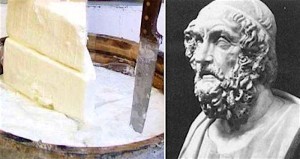As Greece fights to maintain the name of feta cheese as a Protected Designation of Origin (PDI) product, the Real Greek Feta website provides great evidence that the first mention of the famous cheese is as old as Homer’s “Odyssey”.
When Odysseus and his men enter the cave of Cyclops Polyphemus, the first thing they notice is the smell and sight of the rich, white cheese made with goat and sheep milk in brine. Homer writes:
“We entered the cave, but he wasn’t there, only his plump sheep grazed in the meadow. The woven baskets were full of cheese, the folds were full of sheep and goats and all his pots, tubs and churns where he drew the milk, were full of whey. When half of the snow-white milk curdled he collected it put it in the woven baskets and kept the other half in a tub to drink. Why my good ram are you the last to leave the fold? You have never been left behind by the flock before. You were always first walking ahead to graze the tender sheets of grass”.
According to myth, Cyclops Polyphemus made the cheese that was later to be called feta by accident. Transporting the milk that he collected from his sheep in skinbags made of animal stomachs, one day he realized that the milk had curdled and had taken a solid, tasty and conservable form. Given that the “Odyssey” was written in 8th century BC, the origin of feta is indisputably Greek.
The ancient Greeks called the product that came from the coagulation of milk “cheese”. The name Feta, literally meaning “slice,” originated in the 17th century, and probably refers to the practice of cutting the cheese in slices to be placed into barrels. The name Feta prevailed in the 19th century, and since then has characterized a cheese that has been prepared for centuries using the same general method, and whose origin is lost in time.
Source: Philip Chrysopoulos/greekreporter.com
Ask me anything
Explore related questions





